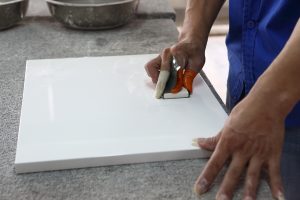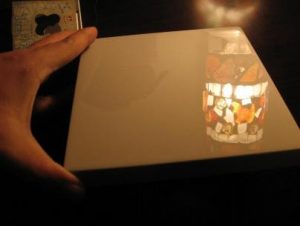Cabinets Surface Treatment
Aug. 02, 2022
1,034 Views
Cabinet finishes
Cabinets may be finished with opaque paint, opaque lacquer and transparent finishes such as lacquer or varnish. Decorative finishes include distressing, glazing, and toning. The choice of finish can affect the cabinet’s color, sheen (from flat to high gloss), and feel.

Lacquer finished door panel
- High-pressure laminates or (HPL) are made from resin and paper components under high pressure; in contrast, ordinary wood does not sustain such pressures, and can be crushed to less than half its natural thickness in a hand-operated arbor press. The high pressure squeezes the HPL to such a solid density that it becomes highly resistant to damage simply because any utensil or tool striking the HPL will not have a force greater than the force used to form the HPL itself. In effect, the HPL has been dented in advance. HPL can be decorated in any pattern and is applied using contact cement and pressed in place using a “J-roller.” It is cut slightly larger than the panel on which it is to be installed and trimmed using a router-like laminate trimmer along the edge. It may also be filed to obtain the final edge. While HPL became prevalent in the twentieth century, since the 1970s the trend has been awayfrom HPL in favor of wood.
- Melamine is a coating for furniture board panels in carcases. Its unique white-in-color chemical formulation helps prevent damage by chemicals and gives it impact resistance comparable to HPL. Melamine coated boards are widely available in home centers for purposes such as shelving.
- Thermofoil is a plastic coating laminate applied to furniture-board. It is typically applied to boards which have been milled, shaped, or routed into a complex profile. While thermofoil can have a unique glossy sheen and have strength and impact resistance almost as much as HPL, it can’t be repaired if damaged.
- Paint is usually applied to maple cabinet doors or to MDF (Medium-density fibreboard) with a spray gun as opposed to a paint brush or roller, in order to achieve a smooth coating. Most large-scale cabinet makers apply one or two coats of primer before the paint as well as a protective coat of lacquer afterwards.

Lacquer finished door panel which is like a mirror
- Stain is a water or thinner based dye that allows for the grain of the wood to show through. When it comes to application there are two main categories of staining. wiping stains and spray stains. Wiping stains are sprayed on to the Wood and then wiped off whereas the spray stain is left to dry without wiping. One thing to keep in mind when it comes to staining it would is that the color of the wood also affects the end result. For example, a stain on oak will not be the same color as the same stain on Maple.
- Veneer refers to thin slices of wood and sometimes bark, usually thinner than 3mm (1/8inch), that typically are glued onto core panels (typically, wood, particle board or medium-density fiberboard) to produce flat panels such as doors, tops and panels for cabinets, parquet floors and parts of furniture. They are also used in marquetry. Plywood consists of three or more layers of veneer. Normally, each is glued with its grain at right angles to adjacent layers for strength. Veneer beading is a thin layer of decorative edging placed around objects, such as jewelry boxes. Veneer is also used to replace decorative papers in Wood Veneer HPL.
Pre:julies-kitchen-cabinets-inspection-and-container-loading-pictures
Next:kitchen-cabinets-wood-choices
Back To The List






